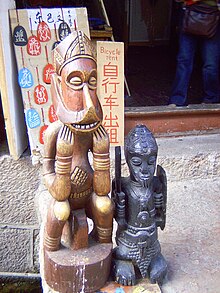

Dongba (Nakhi: ²dto¹mba, Chinese: 东巴; pinyin: dōngbā; lit. 'Ba of the East') refers to both the religion and the priests of the Nakhi people of southwest China.
Role in society
Dongba is believed to have originated from the indigenous Tibetan Bon religion. According to Nakhi legend, these teachings first came to Yunnan from a Bon shaman from eastern Tibet named Dongba Shilo (丁巴什罗). The strong Tibetan influence can be seen today in the rituals and costumes of the Dongba priests, who invoke Bon spirits and are often adorned with pictures of Bon gods on their headgear.
Currently, the religion is deeply ingrained in Nakhi culture, with Dongba priests serving as the primary transmitters of traditional Nakhi culture, literature and the pictographic Dongba symbols. The priests also conduct a variety of rituals to propitiate the many gods and spirits which are believed to play an active part in the natural world. The core of the Dongba religion is based on the belief that both man and nature are two half-brothers born of two mothers and the same father.
Prior to Tibetan influence, it is suggested that the original Nakhi priests were female llü-bu. At that time, statues or religious images could be widely seen everywhere.
A complete annotated translation of ancient Nashi Dongba books (simplified Chinese: 纳西东巴古籍译注全集), in 100 volumes, has been published.
Bibliography
Xu Duoduo. (2015). A Comparison of the Twenty-Eight Lunar Mansions Between Dabaism and Dongbaism. Archaeoastronomy and Ancient Technologies, 3 (2015) 2: 61-81 (links: 1. academia.edu; 2. Archaeoastronomy and Ancient Technologies).
See also
Notes
- Goodman, J.; Yee, J.Y.F. (2022). Peoples Of The Greater Mekong: The Ethnic Minorities. World Scientific Publishing Company. p. 24. ISBN 978-981-12-6176-3. Retrieved 14 March 2024.
- On the Twenty-Eight Lunar Mansions Systems in Dabaism and Dongbaism and on the analysis of the two writing systems according to an innovative interpretation, cf. XU Duoduo. (2015). A Comparison of the Twenty-Eight Lunar Mansions Between Dabaism and Dongbaism. «Archaeoastronomy and Ancient Technologies», 3 (2015) 2: 61-81 (links: 1. academia.edu; 2. Archaeoastronomy and Ancient Technologies)
- "翻译人亡技绝 文献变"天书":滇抢救少数民族古籍". dongnanyanet.com. Archived from the original on 25 September 2015.
- "杨一奔委员:建议抢救性翻译《东巴经》 – 中国民族宗教网". mzb.com.cn. Archived from the original on 25 September 2015.
External links
- Dongba culture related art
- A series of Dongba Culture artworks by Dongba ethnic artist Cun Liusan.
- Edongba – Input Dongba hieroglyphs and Geba symbols.